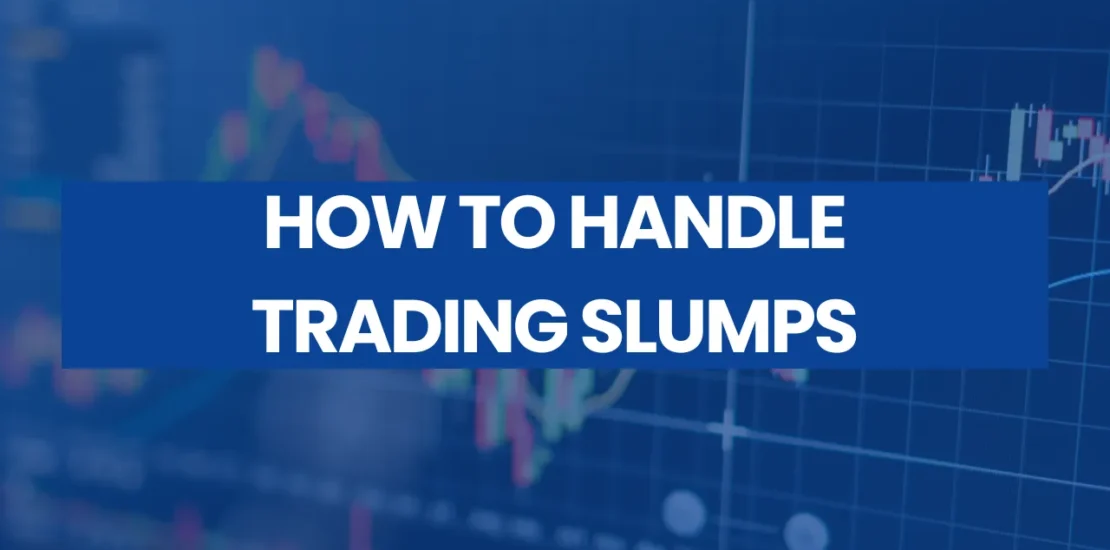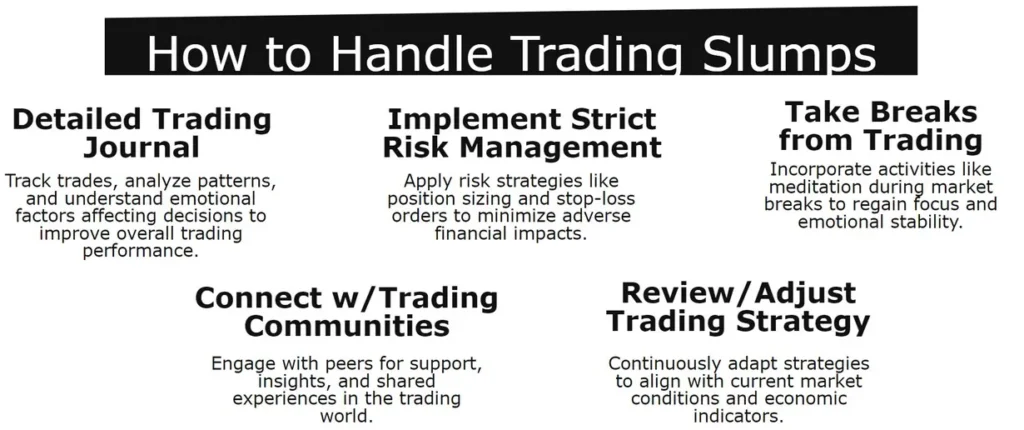- January 13, 2025
- Posted by: Shane Daly
- Category: Trading Article

Trading slumps are an inevitable reality that every traders faces, regardless of experience level or trading strategy. These challenging periods can drain both capital and confidence, leading many traders to question their methodology and decision-making abilities. While the natural instinct might be to dramatically alter your trading approach or give it up entirely, successfully handling downturns requires a more measured and systematic response.
Understanding the psychological, technical, and risk management components of trading slumps becomes essential for transforming these difficult phases into opportunities for growth and improvement.

Understanding Market Downturns
Market downturns are inevitable phases in the trading cycle, presenting unique challenges that can test even seasoned traders. When we examine these periods, we can identify clear patterns that help us handle these trading slumps more effectively.
The classic bear market, marked by a 20% or more decline from recent highs, acts as a prime indicator that conditions have fundamentally shifted, requiring traders to adapt their strategies.
Understanding market downturns involves recognizing their early warning signs through economic indicators. I’ve seen that rising unemployment rates, declining consumer confidence, and decelerating GDP growth often front-run significant market corrections.
These signals, combined with volatility spikes measured by the VIX index, create a complex trading environment that requires more attention to managing risk. While typical market corrections may resolve quickly, bear markets can persist for roughly 1.5 years, making it important to maintain perspective and adjust expectations.
As traders, we must remember that market dynamics during downturns differ substantially from bull markets, requiring us to modify our approach and potentially reduce position sizes to preserve capital during extended periods of uncertainty.
During challenging market conditions, utilizing the Supertrend Indicator can help identify trend reversals and provide clear buy/sell signals to help you handle volatile periods more effectively.
Signs You’re Hitting Bottom
When traders hit the depths of a slump, mounting losses often create a destructive cycle where decreased confidence leads to emotionally-driven decisions.
I’ve seen countless traders, myself included, fall into the trap of letting consecutive losses erode their discipline, replacing the strategy with gut reactions and hope. Understanding win/loss dynamics is important for maintaining perspective during difficult trading stretches.
As your trading account shrinks and anxiety rises, the temptation to abandon proven (and tested) methods grows stronger, pushing many traders into a spiral of overtrading and increasingly risky positions.
Successful traders overcome these challenges by maintaining strict risk management through position sizing and portfolio diversification to protect capital during difficult periods.
Mounting Losses Drain Confidence
During periods of mounting losses, traders often experience a an erosion of confidence that can spiral into increasingly poor decision-making.
As someone who’s witnessed countless trading slumps, I can say that this psychological shift typically showing up as a self-reinforcing cycle of anxiety and self-doubt, where each loss feels more significant than the last.
What makes this situation more challenging is how traders tend to abandon previously effective strategies when faced with consecutive losses. At Netpicks, we see many traders with our proven systems fall into a few natural losses. Some want to change the approach entirely thinking there is a magic solution to the losses.
I’ve seen that emotional resilience becomes critically important during these periods, as the natural inclination is to overtrade or make impulsive decisions in an attempt to recover losses quickly.
These reactions are understandable but often lead to increased transaction costs and deeper financial hits.
The key is recognizing these warning signs early.
When you notice yourself second-guessing every trade, feeling anxiety before entering positions, or deviating from your established trading plan, you need to step back and assess your psychological state.
Emotional Trading Takes Over
A important inflection point in trading slumps emerges when emotional decision-making completely overtakes rational analysis. As traders, we often witness this transformation through behaviors like overtrading, revenge trading, or desperately chasing losses, all of which comes from unchecked emotions rather than depending on your strategy.
When emotional trading takes control, maintaining a positive mindset becomes increasingly difficult as anxiety and irritability cloud judgment. I’ve seen (and experienced) traders falling into the trap of seeking comfort in market predictions rather than focusing on present conditions, leading to poor risk management decisions.
The impact becomes evident through impulsive actions, frequent deviations from their established trading plans, and a growing sense of pessimism about market opportunities.
To identify areas for improvement during these phases, traders should watch for signs such as excessive self-doubt, deteriorating decision quality, and an inability to stick to predetermined strategies.
Understanding these warning signals can help you recognize when emotions are steering your trading decisions, allowing you to step back and reassess before further damage occurs to your portfolio and trading confidence. Work the fix!
Managing Your Mental Game
The psychological aspect of trading can make or break your success, particularly during challenging market periods. When facing a trading slump, maintaining emotional discipline becomes important, as our natural instincts often push us toward impulsive decisions that can worsen our situation.
I’ve found that managing your mental game effectively requires a multi-faceted approach. Start by keeping a detailed emotional journal to track your psychological state during trades, which helps identify patterns and triggers that may be affecting your performance.
Additionally, engaging in stress-relief activities, such as meditation or exercise, can provide the mental reset needed to approach the markets with renewed clarity. Understanding that trading is a probabilities game helps maintain perspective during difficult periods.
Building connections with other traders has proven essential during difficult periods. These relationships not only offer emotional support but also provide fresh perspectives on market conditions and trading strategies. Even conversations on “X” can be helpful although social media traders all seem to have 100% rates.
Remember to acknowledge and celebrate small victories along the way, as these moments of success, however modest, help maintain confidence and motivation.
When we focus on maintaining psychological balance, we’re better equipped to weather trading storms and emerge stronger on the other side.
Avoiding herd mentality in group trading environments is essential for maintaining independent judgment and preventing emotionally-driven decisions.
Risk Assessment During Losses
Professional risk assessment consistently remains the cornerstone of loss management during trading slumps. When facing consecutive losses, I’ve found that implementing a structured trading plan with strict loss thresholds, typically 1-2% of total equity per trade, helps prevent catastrophic drawdowns that could destroy your portfolio.
A systematic approach to risk management involves multiple protective layers, including diversification across asset classes and proper position sizing. By keeping individual positions between 5-10% of your total capital, you’ll shield yourself from excessive exposure to any single trade’s potential downside.
This is just ONE example on how to handle position sizing and allowable stop loss.
| Parameter | Value | Calculation |
|---|---|---|
| Total Account Size | $5,000 | – |
| Position Size (7%) | $350 | 7% of $5,000 |
| Number of Shares | 7 shares | $350 ÷ $50 |
| Stock Price (XYZ) | $50 per share | – |
| Stop Loss Percentage | 2% | – |
| Maximum Loss Amount | $7 | 2% of $350 |
| Maximum Loss per Share | $1 | $7 ÷ 7 shares |
| Stop Loss Price | $49 | $50 – $1 |
Additionally, you should utilize stop-loss orders strategically to automate your risk controls and remove emotional decision-making from the equation.
One often-overlooked aspect of risk assessment is maintaining a detailed trading journal to track your losses. By reviewing your journal regularly, you can identify patterns that lead to larger-than-normal losses and adjust your strategy accordingly.
Trust me, the patterns you’ll discover in your trading history often reveal precisely where your risk management needs fine-tuning, allowing you to make data-driven adjustments to your approach.
Building A Recovery Strategy
With risk assessment measures firmly in place, developing an effective recovery strategy becomes the next logical step in managing trading slumps.
In my experience, successful traders understand that downturns are natural waves in their trading journey, not permanent setbacks that define their capabilities.
A well-structured recovery strategy begins with maintaining detailed trading journals, where we can identify patterns and pinpoint specific areas requiring improvement.
Combining this analytical approach with strict risk management protocols, particularly through strategic stop-loss placement, creates a strong framework for recovery from drawdowns.
During challenging periods, make sure to step back and do other activities that clear your mind, whether that’s exercise, meditation, or simply taking a short break from the markets.
Trading Journal Best Practices
Successfully handling of trading slumps requires careful documentation through a well-structured trading journal. By carefully recording our trades, including setup conditions, position sizes, and market catalysts, we create a reliable database of understandings that can help us through challenging periods.
I’ve found that the most effective trading journals incorporate both technical and emotional elements, as understanding our psychological state during trades is important for developing emotional resilience.
When reviewing your journal entries, pay particular attention to patterns in your decision-making, especially during periods of market volatility or personal stress.
Make it a habit to document not just what you traded, but why you entered positions and how you felt about each decision.
Regular journal reviews should become part of your weekly routine, ideally during quiet market hours when you can focus on analysis.
Structure your entries with clear categories: trade setups, risk management decisions, market conditions, and personal observations. This approach allows you to identify recurring mistakes, refine successful strategies, and adapt your trading plan to evolving market conditions with greater confidence and accuracy.
Adjusting Position Sizes
A trader’s position sizing strategy plays a huge role when going through trading slumps. When performance drops, adjusting position sizes becomes a important defensive measure that can help minimize risk exposure while maintaining strategic control over trading capital.
I’ve found that scaling back positions by 50% or more during challenging periods provides the breathing room needed to reassess and refine trading approaches.
Implementing a fixed fractional position sizing method offers a systematic way to manage risk during downturns, allowing traders to maintain emotional discipline when market conditions become challenging.
| Account Balance | Risk Percentage | Amount Risked/Trade | Position Size (Assuming $200 Risk per Trade) |
|---|---|---|---|
| $10,000 | 2% | $200 | 1 contract (if each contract risks $200) |
| $12,000 | 2% | $240 | 1 contract (if each contract risks $240) |
| $8,000 | 2% | $160 | 1 contract (if each contract risks $160) |
| $15,000 | 2% | $300 | 1 contract (if each contract risks $300) |
By reducing position sizes, we can effectively decrease the psychological pressure that often accompanies trading slumps, making it easier to focus on strategy refinement rather than recovery from substantial losses.
This approach helps counteract the natural tendencies toward fear and greed that typically intensify during periods of poor performance.
Regular review and adjustment of position sizes should align with both market volatility and personal trading performance.
When we adapt our sizing strategy to current market conditions, we create a more sustainable framework for steering through difficult trading periods while preserving capital for future opportunities.
Learning From Past Mistakes
Three essential components of managing trading slumps involve documenting, analyzing, and learning from past trading mistakes.
To effectively overcome trading challenges, traders need to maintain detailed journals that track both their technical decisions and emotional states during trades.
| Action Step | Helps With |
|---|---|
| Daily Trade Journaling | Clear pattern identification |
| Emotional State Tracking | Understanding psychological triggers |
| Setup Documentation | Improved strategy refinement |
| Performance Analysis | Improved future decision-making |
When reviewing past performance, I’ve found that combining quantitative data with qualitative observations helps identify potential areas for improvement. By examining your trading journal during difficult periods, you can spot recurring issues that may not be obvious in the heat of the moment. T
he structured analysis of previous trades, including position sizing, entry timing, and exit strategies, provides valuable feedback for strategy adjustment.
Regular review sessions become particularly powerful when you correlate market conditions with your documented trades, allowing you to recognize which environments best suit your trading style. Think of the review session as the trader meeting with the risk manager – two different hats.
This systematic approach to learning from mistakes can turn the losing streaks into valuable learning experiences that strengthen your trading foundation.
Market Analysis Techniques
When facing a trading slump, I’ve found that returning to disciplined market analysis through both technical and fundamental approaches can help restore trading confidence and direction.
By examining technical chart patterns, including support and resistance levels, moving averages, and momentum indicators, we can better identify potential entry and exit points while minimizing emotional decision-making.
Combining these technical observations with fundamental market indicators, such as economic data releases, industry trends, and broader market sentiment, creates a more complete picture that can guide us through challenging trading periods.
Technical Chart Patterns
Technical chart patterns are essential tools for traders dealing with market slumps, offering structured approaches to analyze price movements and identify potential trading opportunities.
When market conditions become challenging, I’ve found that recognizing key patterns can help us maintain objectivity and make data-driven decisions.
Let’s look at some fundamental patterns and their implications:
| Pattern Type | Signal Type | Reliability | Best Usage |
|---|---|---|---|
| Head & Shoulders | Reversal | High | Major Trends |
| Double Tops/Bottoms | Reversal | Medium | Support/Resistance |
| Flags/Pennants | Continuation | High | Ongoing Trends |
| Candlestick Patterns | Short-term | Medium | Entry/Exit Points |
Volume analysis plays a important role in confirming these patterns, as increased trading activity during pattern formation often validates the potential price movement.
While no pattern guarantees success, combining technical chart analysis with volume indicators strengthens our ability to identify reliable trading signals.
During slumps, these patterns become particularly valuable as they help maintain a systematic approach to trading, reducing emotional decision-making that often plagues traders during challenging periods.
Fundamental Market Indicators
Beyond chart patterns, fundamental market indicators provide traders with a comprehensive framework for understanding broader market dynamics during slumps.
When I analyze market trends during difficult periods, I’ve found that keeping a close eye on GDP growth rates, employment statistics, and inflation data helps maintain perspective on the bigger economic picture.
During trading slumps, it’s important to remember that corporate earnings reports and guidance serve as essential signals for potential price movements, while interest rate decisions by central banks can dramatically shift market sentiment.
I always advise traders to incorporate both company-specific metrics and broader economic indicators into their trading decisions, particularly when maneuvering through challenging periods. Of course commodity traders will depend on other variables.
For instance, monitoring consumer spending patterns and confidence indexes can reveal early warning signs of market shifts.
To stay ahead of market-moving events, you’ll want to maintain a detailed Economic Indicators Calendar, which helps time your trades around significant data releases.
This systematic approach to fundamental analysis becomes especially valuable during slumps, when emotional decision-making might otherwise cloud your judgment.
Your Questions Answered
What Is the 90% Rule in Trading?
The 90% Rule states that 90% of traders lose 90% of capital within 90 days, primarily due to poor trading psychology, inadequate risk management, and lack of consistent performance reviews.
Why Do 98% of Traders Fail?
Most traders fail due to poor risk management practices, inability to develop emotional resilience during market volatility, and failure to make necessary mindset shifts required for successful trading.
What Is the 3-5-7 Rule in Trading?
The 3-5-7 rule combines risk management strategies with trading psychology techniques, requiring traders to make three trades, analyze five trades, and review seven rules while tracking performance each session.
What Is the 1% Rule in Trading?
The 1% Rule limits risk exposure to 1% of total trading capital per trade, promoting consistent trading habits and sound risk management strategies while reducing emotional stress in market psychology.

